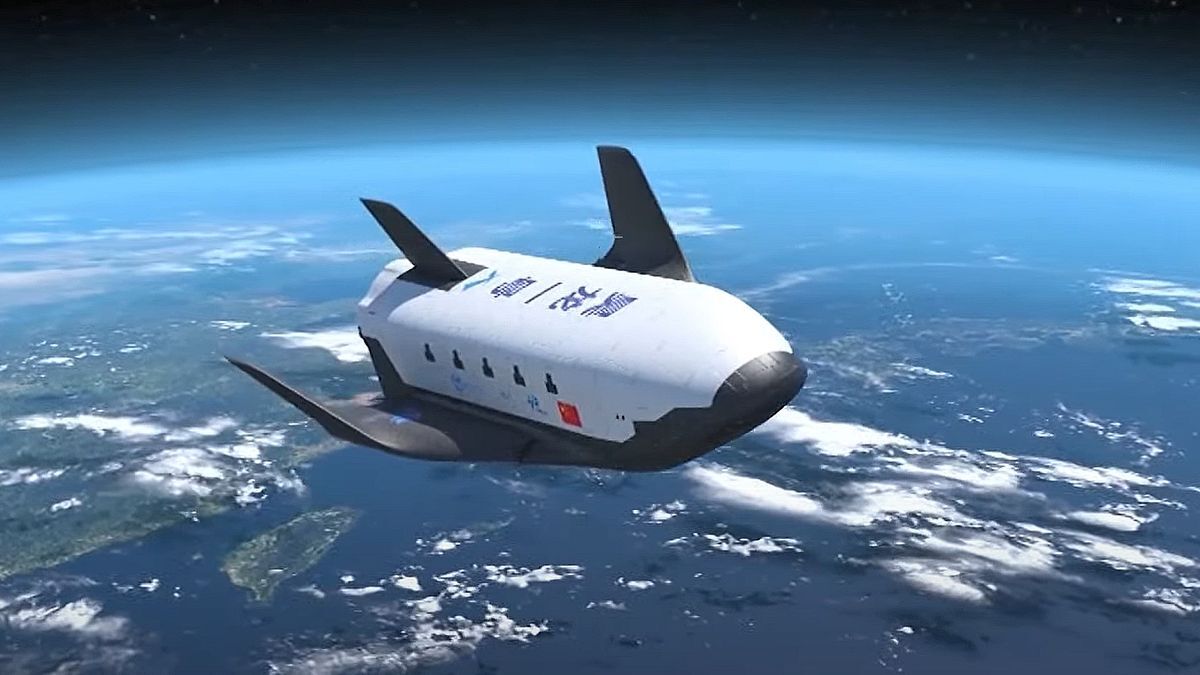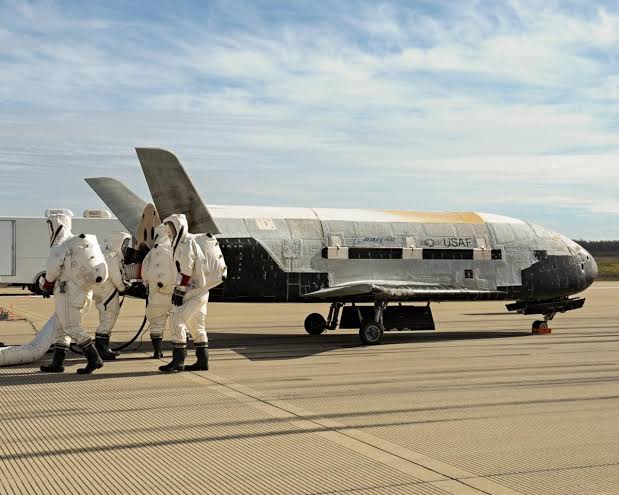China has unveiled the design of a new reusable shuttle to take cargo to and from the country's space station.
The Haolong space shuttle is being developed by the Chengdu Aircraft Design and Research Institute under the state-owned Aviation Industry Corporation of China (AVIC). It is one of two winning projects stemming from a call for proposals from China's human spaceflight agency, CMSA, to develop low-cost cargo spacecraft.
China currently uses its robotic Tianzhou spacecraft to send cargo to the Tiangong space station. But, taking a leaf out of NASA's book to encourage commercial resupply options for the International Space Station, CMSA wanted new, low-cost ideas that can also return experiments and other cargo to Earth, unlike the Tianzhou, which burns up on reentry.
Haolong will launch atop of a rocket and land horizontally on Earth on a runway. The space shuttle measures 32.8 feet (10 meters) long and 26.2 feet (8 m) wide, and weighs less than half of the Tianzhou capsule, which has a mass of up to 31,000 pounds (14,000 kilograms). The winged spacecraft is now in the engineering flight verification phase, meaning its design and systems are under review before being built.
(Update: the video seems not to work for me, but I found the right video on youtube showing how a flight would work.)
It will be hilarious if China builds the Space-Shuttle-That-Should-Have-Been, rather than the abomination that NASA was forced to build. Scale it up & put this on top of a reusable booster and you have a fully reusable system like SpaceX is currently testing.
EDIT: Ah I see this is small in scale, like X-37. Would love to see it reach the size of Dreamchaser or bigger.
It will be hilarious if China builds the Space-Shuttle-That-Should-Have-Been, rather than the abomination that NASA was forced to build.
No kidding! The way the US Air Force treated NASA during the design phase of the Space Shuttle is disgraceful, and the root cause of all other space shuttle issues. I don't blame NASA for the design flaws of the space shuttle, I just blame them for operating it unsafely while knowing those design flaws. For those unfamiliar it's a pretty crazy story that deserves its own effortpost. The really short version is that the USAF promised to fund development and operations of the space shuttle in exchange for the space shuttle being designed to be able to capture enemy satellites and bring them down to US soil intact. This came at the expense of drastically increased complexity and size, mostly for the oversized cargo bay, which in turn required it to be launched on the side of its disposable fuel tank with additional dangerous solid rocket boosters (SRBs) strapped to it, instead of safely on top of a purely liquid-fueled rocket.
Most early space shuttle concepts were like this, a fully reusable system without SRBs, which more closely resemble the Starship/Super Heavy design. Two vehicles with purely liquid-fueled engines, of roughly equal sizes and stacked vertically. But with large wings for runway landings of both ship and booster, instead of Starship's vertical tower-catch landings and stubby flaps and grid fins just for aerodynamic control.
Show
And just as soon as the design was finalized and construction began, the USAF gave NASA a figurative middle finger and pulled out, deciding that they didn't care about capturing satellites and wanting to launch their own satellites on regular uncrewed rockets instead. But it was too late for NASA to redesign anything, because the additional cost could have killed all funding from the US senate. They were stuck with the dangerous, difficult-to-fly monstrosity bolted on the side of a super-cold hydrogen/oxygen fuel tank that always dropped chunks of ice and insulation foam on every launch. The 27th shuttle flight almost ended up like the Columbia disaster due to heat shield damage from debris during launch. By pure dumb luck the damaged heat shield sections were over more sturdy parts of the spaceframe and Atlantis landed intact.
yeah it's a wild journey discovering that the $pace shit-le sucked, actually.
For those unfamiliar it's a pretty crazy story that deserves its own effortpost.
I need to get around to making part 2 one of these days, but here
Damn, that's a masterpiece! Thank you.
And I just realized I read it before! But well worth reading again.
But, taking a leaf out of NASA’s book to encourage commercial resupply options
Feels more like they are looking at the space shuttle program and seeing a potental for less materials to be spent if they allow reusable, but thats just me
Nothing says "encourage commercial resupply options" like a resupply vessel developed and produced by the state-owned Aviation Industry Corporation of China
I'm wondering if there's a nuance that's been lost in translation. Maybe "commercial" isn't quite the right english word.
I almost garentee that this is an editoralization on space.com hyping up the "private space race"
Or just a lib writer being unable to conceive of any other approach
I mean MAYBE but I don't buy that, the space shuttle wasn't that long ago
Laws of physics at work. Similar aerospace engineering challenges will have similar solutions, regardless of who does the R&D.
Hopefully it works better than the US Space Shuttles and Buran. I'm sure being not being crewed would help.
The Buran's fatal flaw had a very large birthmark, this doesn't seem to have that weakness
the Buran was awsome ... and I am so glad the birthmark no longer exists
Buran was probably the best and safest way to built a side-mounted reusable spaceplane. Still not a great idea overall, but Buran's engineers made the least-stupid vehicle possible with that layout. Aside from the basic exterior shape of the shuttle which was always going to be similar due to aerodynamics, Buran was completely different from the space shuttle internally. It was not a "copy" as some jingoistic American space historians like to call it.
There were plans to develop Energia into a fully reusable vehicle, but then 1991 happened and R&D funding for that dried up. Energia was a really flexible rocket too. Because the main engines were on the fuel tank section and not the shuttle section, Energia was a proper independent rocket and could operate without Buran to lift heavy payloads solo. A lot of R&D work went into making a very smart autonomous guidance system for Energia so that it could basically lift anything that would fit on top or on the side without having to do a lot of wind tunnel testing and one-off guidance computer programming.
I found a YouTube link in your comment. Here are links to the same video on alternative frontends that protect your privacy:
it's design is very similar to that of the currently operating X-37, so it should be fine. it has neither of the US Space Shuttle's fatal flaws.
It's on top of the stack in a fairing, not strapped to the side where shit can fall on it.
The ability to return experiments to Earth will be huge for their scientific programs. Right now the CNSA lacks that capability. Their current cargo vehicle (Tianzhou) is a variant of their space station modules, which themselves are modernized variants of the USSR's Salyut station module design. I doubt Haolong will be developed into a crew vehicle but I would bet that the lessons learned from it will be used in future crew vehicles.
Update: Found a working video of how a typical flight will go. I added the youtube link to the post. I really like the idea of integrating the solar panels and radiators into folding panels on the top of the spacecraft. That will help immensely with keeping costs down and turnaround time quick. The American Dream Chaser, which is a broadly similar design for a similar-sized uncrewed cargo spaceplane and is due to launch soon on its first test flight, launches with a disposable power and propulsion section that needs to be rebuilt from scratch with each flight. That keeps R&D costs down but it increases per-flight costs and increases the turnaround time.









